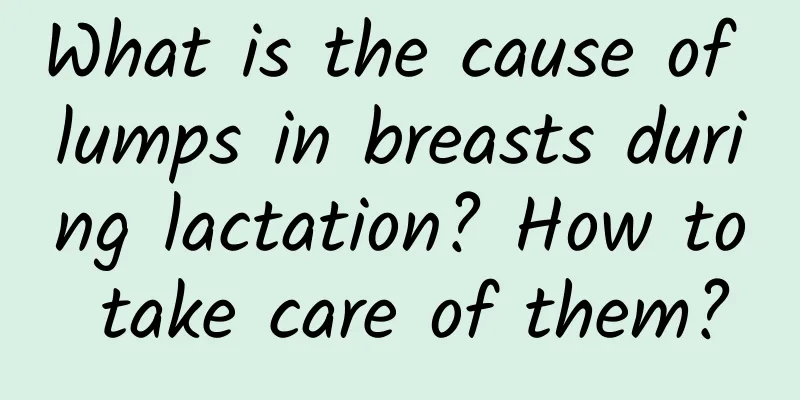What is the cause of lumps in breasts during lactation? How to take care of them?

|
Many new mothers will encounter various problems when breastfeeding their children. Due to lack of experience, they are often confused. One of the most common problems is that the mother feels a lump in the breast when breastfeeding. So what exactly is going on? The following article will explain in detail. 1. What are the common problems during breastfeeding? (1) Breast pain and mastitis: During breastfeeding, the breasts may feel pain, congestion, mastitis, etc. This may be caused by milk blockage, breast infection, etc., which can be relieved through correct breastfeeding posture, massage, hot compress, etc. (2) Cracked and sore nipples: Breastfeeding can sometimes cause cracked or sore nipples, usually because the baby sucks incorrectly or with too much force. Correct posture and the use of nipple protectors can alleviate these problems. (3) Too much or too little milk: Some mothers may face the problem of too much or too little milk. Too much milk can cause breast pain, while insufficient milk affects the baby's adequate feeding. Adjusting the frequency of breastfeeding, breastfeeding on demand, and maintaining adequate water intake can help regulate milk secretion. (4) Blocked milk ducts: Blocked milk ducts lead to poor milk secretion and increase the risk of mastitis. Regular breastfeeding, breast massage, and keeping breasts unobstructed can prevent blocked milk ducts. (5) Baby sucking problems: Sometimes babies have difficulty sucking and swallowing problems, which are caused by incorrect posture, insufficient sucking power, etc. Consulting a doctor or a professional lactation consultant can help solve these problems. (6) Malnutrition: Mothers need additional nutrition during breastfeeding to meet the needs of themselves and their babies. Poor eating habits lead to malnutrition, which affects the quality of breast milk and the health of the baby. Mothers should maintain a balanced diet to ensure adequate nutrition. 2. Causes of lumps in breasts during lactation (1) Milk blockage: Milk is blocked in the milk duct and cannot be discharged normally, resulting in a lump in the breast. This is caused by incorrect breastfeeding posture, nipple damage, milk duct blockage, etc. (2) Mastitis: Mastitis refers to inflammation caused by infection of breast tissue, usually accompanied by symptoms such as local redness, swelling, pain, and lumps in the breast. Mastitis is caused by bacterial infection or milk blockage. (3) Breast cyst: Breast cyst refers to the cystic proliferation of breast tissue, forming a cyst-like mass, causing the breast to feel lumpy. Breast cysts are usually benign, but sometimes they can cause discomfort or pain. (4) Breast hyperplasia: Breast hyperplasia refers to the proliferation or increase of breast tissue, resulting in a lump in the breast. Breast hyperplasia is usually caused by hormonal changes or increased sensitivity of breast tissue to hormones. (5) Breast cancer: Although breast cancer is rare during breastfeeding, symptoms of breast lumps can still occur. If breast lumps persist, grow in size, and are accompanied by other abnormal symptoms (such as nipple discharge, skin changes, etc.), you should seek medical attention in a timely manner to rule out the possibility of breast cancer. 3. Nursing methods for breast lumps during lactation (1) Correct breastfeeding posture: Ensure that the mother and baby have the correct breastfeeding posture. When the baby sucks the breast, the lips should be turned outward and the nipple should be located deep in the mouth to reduce the possibility of milk blockage. (2) Frequent breastfeeding: Maintain regular breastfeeding and breastfeed on demand. Do not keep the breasts full for too long to avoid milk retention in the milk ducts. (3) Hot compress: Using hot compress before breastfeeding can help unclog the mammary glands and promote milk secretion. You can use a warm water bag, hot towel or hot water soaking for hot compress. (4) Massage: Gently massaging the breasts before and after breastfeeding can help promote milk secretion and breast duct patency. When massaging, gently push from the base of the breast toward the nipple. (5) Cold compress: Using cold compress after breastfeeding can help relieve breast pain and swelling. You can use a cold compress pad, ice pack or cold towel. (6) Proper rest: Maintaining a good rest state and avoiding excessive fatigue will help regulate hormone levels and breast function. (7) Wear appropriate underwear: Choose appropriate underwear and avoid wearing bras that are too tight or ill-fitting to avoid compressing the breasts and mammary glands. (8) Diet and water intake: Maintaining a balanced diet and drinking enough water will help maintain good milk secretion and breast health. (9) Avoid over-stimulation: Avoid over-stimulation of the breasts, such as over-squeezing the breasts, over-cleaning the breasts, etc., so as not to aggravate mastitis or breast blockage. 4. Summary Various problems encountered during breastfeeding must be solved scientifically and reasonably. Do not use the "old methods" without authorization. Once the discomfort worsens, seek medical attention in time. Breastfeeding should be taken seriously for both the child and the mother. If breastfeeding women ignore their own health problems, it will also affect their quality of life in the future. Author: Zhong Xiaomei, Gaozhou Maternal and Child Health Hospital, Guangdong Province |
<<: Brief discussion: Spring in the four seasons
>>: My child sweats profusely all the time, what should I do?
Recommend
Is delayed menstruation a sign of pregnancy?
Female menstruation is a normal physiological law...
The flowers are blooming, the grass is green, and the "circle of friends" of common diseases in spring has also become lively...
Author: Deng Chaoyin, pharmacist at Jiugang Hospi...
How to eliminate bad breath in women
Bad breath is also common among girls, which has ...
Methods of expelling uterine residues
The topic of uterine remains has become a hot top...
What happens if there are blood clots like meat during menstruation?
Under normal circumstances, when women have their...
What is postmenstrual disease?
Most female friends will feel some discomfort in ...
Can pubic hair be removed?
Pubic hair is the hair in a woman's more priv...
What to do if you have colitis at 35 weeks of pregnancy
Pregnancy has a significant impact on women's...
What to do if a pregnant woman has blisters from burns
Burns are quite common in daily life. However, th...
Will the second menstrual period be delayed after abortion?
After an abortion, if you have a menstrual period...
What are compressed biscuits? What flavors do compressed biscuits have?
The production of compressed biscuits is relative...
The bleeding is still there on the 7th day of medical abortion
Women need to recuperate for a long time after a ...
Why do I have lower abdominal pain after sex?
In life, sometimes we feel unwell after having se...
How to determine the left and right side pattern of ovulation?
Anyone with a little knowledge of physiology know...









